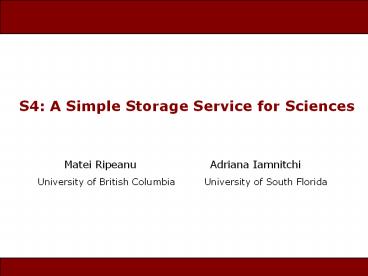S4:%20A%20Simple%20Storage%20Service%20for%20Sciences PowerPoint PPT Presentation
Title: S4:%20A%20Simple%20Storage%20Service%20for%20Sciences
1
S4 A Simple Storage Service for Sciences
- Matei Ripeanu Adriana Iamnitchi
- University of British Columbia University
of South Florida
2
The Situation
- Services as utilities have gained traction
- Economy of scale ? lower costs
- One of the present drivers for Grid computing
- Success story Amazon Simple Storage Service (S3)
- S3 growth is capacity constrained
- Direct access to storage open protocols, APIs
- Performance claims
- Infinite data durability, 99.99 availability,
fast access - Billing pay-as-you go
- 0.15/month/GB stored 0.13-0.18/GB transferred
- Science communities are huge storage users
3
The Motivating Questions
- The immediate question Is offloading data
storage to a storage utility feasible and
cost-effective for science Grids? - The long-term question How should a storage
utility that targets scientific applications look
like?
4
The Approach
- Characterize S3
- Does it live up to its own objectives?
- Toy scenario consider a representative
scientific application (DZero) - Is the functionality provided adequate?
- Estimate performance and costs
- Q Is offloading data storage from an in-house
storage system to S3 feasible and cost-effective
for science Grids?
5
The Answer Risky.
- New risk direct monetary loss
- Magnified as there is no built-in solution to
limit loss - In addition to well-known risk in distributed
systems - Security mechanisms -- too simple to be useful
for large collaborations - Access control using ACLs,
- hard to use in large systems, needs at least
groups - No support for delegation
- Implicit trust between users and the S3 service
- No transaction receipts, no support for
un-repudiabiliy - But standard techniques to deal with these
problems
6
The Answer Costly.
- Scenario S3 used by a high-energy physics
collaboration - The DØ Experiment
- Traces from January 03 to March 05 (27 months)
- 375TB stored, 5.2 PB processed, 561 users, 13
countries
Data S3 Processing DØ Storage
675K Access 462K (per year)
S3 DØ 675K 66K
S3 EC2 675K 44K
S3 DØ 200K400K 66K
- Realize that data gets cold
- archive cold raw-data
- throw away cold derived data (keep definitions)
Add caching 4TB/site cooperative cache
Move processing to EC2
7
Guidelines for a Simple Storage Service
for Sciences (S4)
- Unbundle performance characteristics
- S3 high-availability, high-durability,
high-access performance, bundled at a single
pricing point - Applications often do not need all three
- Each characteristic requires different resources
and generates different costs - Solution classes of service that allow
applications to specify their requirements and
chose pricing point - Exploit usage patterns
- e.g., data gets cold
- Facilitate the use of application-level
information to reduce costs - E.g., raw vs. derived data
8
- Questions?
- To access the S3 evaluation technical report
http//www.ece.ubc.ca/matei
9
Simple Storage Service (S3) Architecture
- Two level namespace
- Buckets (think directories)
- Unique names
- Two goals data organization and charging
- Data objects
- Opaque object (max 5GB)
- Metadata (attribute-value, up to 4K)
- Functionality
- Simple put/get functionality
- Limited search functionality
- Objects are immutable, cannot be renamed
- Data access protocols
- SOAP
- REST
- BitTorrent
10
S3 Architecture (cont)
- Security
- Identities
- Assigned by S3 when initial contract is signed
- Authentication
- Public/private key scheme
- But private key is generated by Amazon!
- Access control
- Access control lists (limited to 100 principals)
- ACL attributes
- FullControl,
- Read Write (for buckets only for writes)
- ReadACL WriteACL (for buckets or objects)
- Auditing (pseudo)
- S3 can provide a log record
11
S3 Evaluation
- Durability
- Perfect (but based on limited scale experiment)
- Availability
- Four weeks of traces, about 3000 access requests
from 5 PlanetLab nodes - Retry protocol, exponential back-off,
- Cleaned data
- 99.03 availability after original access
- 99.55 availability after first retry
- 100 availability after second retry
- Access performance
12
Characteristics Resources and techniques to provide them
High-performance data access Geographical replication to improve access locality, high-speed storage, fat networks.
Durability Replication at various scales RAID, erasure codes, multiple locations, multiple media.
Availability service replication, hot-swap technologies, multi-hosting, increase availability for auxiliary services (e.g., authentication, access control)
13
Application class Durability Availability High access speed
Cache No Depends Yes
Long-term archival Yes No No
Online production No Yes Yes
Batch production No No Yes

